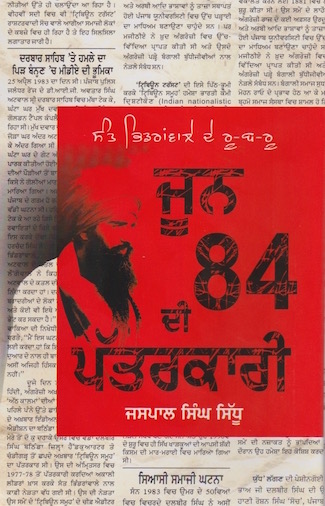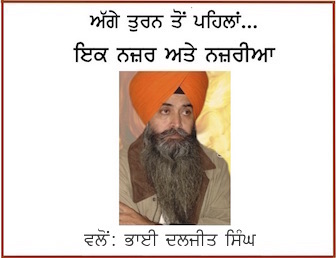Articles/Opinion » Sikh News
After 31 years Journalist Sanjay Suri shares his “not reported” story about visit to Sant Bhindranwale’s village on 6 June, 1984
July 1, 2015 | By Sikh Siyasat Bureau
New Delhi/ Amritsar: An Indian journalist, Sanjay Suri, has shared a “story” about his visit to Sant Jarnail Singh Khalsa Bhindranwale’s village on June 06, 1984, the day when Sant Bhindranwale laid his life, and attained martyrdom, while defending the Darbar Sahib complex from brutal army attack by Indian forces.
![Sant Jarnail Singh Khalsa Bhindranwale [File Photo]](https://sikhsiyasat.net/wp-content/uploads/2015/07/Sant-Jarnail-Singh-Khalsa-Bhindranwale.jpg)
Sant Jarnail Singh Khalsa Bhindranwale [File Photo]
An excerpt published by Outlook magazine under title: “The Story I Did Not Report In ’84” (by Sanjay Suri) shares the experience of journalist who visited village Rode in Moga district of Punjab. Sanjay Suri has drawn a clear contrast that how he, despite being a strange Hindu in one of the most (suspectedly) volatile villages of Punjab at that time, was offered rest and meal on the day when Sant Jarnail Singh Bhindranwale was declared dead by the Indian government; but on the other hand how thousands of Sikhs were massacred in Delhi (and elsewhere in Indian subcontinent) after the assassination of the then Indian Prime Minister Indira Gandhi.
BUY BOOK on Journalism of 1984:

SANT BHINDRANWALE DE RU-B-RU JUNE 84 DI PATARKARI (BUY THIS BOOK NOW)
Full text of write-up published by Outlook is being reproduced as follows, for the information of readers of Sikh Siyasat News:-
EXCERPT
The Story I Did Not Report In ’84
On the day Bhindranwale was declared killed, I, a Hindu stranger, was at his house. No one killed me for looking Hindu, but Sikhs in Delhi were massacred for being Sikhs.
SANJAY SURI
Getting from Moga to Rode turned out to be a long haul. I could not find a taxi. The bus services were still jagged. I found a bus that took me to Faridkot. After a longish wait, I found a tempo that took me further towards Rode. That ride still ended miles away from where I was told Bhindranwale’s home was. I wasn’t stuck for the lack of an address though—who in that area wouldn’t know Bhindranwale’s house? I just couldn’t find anyone to take me there. On that sizzling afternoon in June, not many were around at that small kasba—a sort of village town—where the tempo had dropped me.
Some people by the roadside told me Bhindranwale’s house was not far and pointed the way. I began walking. As always, kindly estimates of distance fell far short of the real distance itself—the Indian compulsion to be kind at such times always overrides any approach towards accuracy. I walked for what seemed a long time along the side of a road, confirming with anyone I could that I was headed the right way. Maybe the distance felt longer in that heat than it really was. I was getting close to exhaustion along the way when I found an unexpected lift.
A youngish Sikh chap I asked directions for said he’d take me to Bhindranwale’s home. He wheeled out his bicycle from under a tree, and I hopped aboard on the carrier at the back. He rode on to some track in a field, then on to a small road of sorts. I had no idea where I was going. I asked politely if I should take turns doing the cycling, or that he could stop and let me walk the rest. My guilt rose with every passing minute that he should be sweating away lugging me as burden through that afternoon heat. He was impatiently dismissive of my polite offerings.
It felt like a long ride on the bicycle—allowing again for the certainty that it would always feel longer than it was. And then, suddenly, I saw where we were headed. I heard before I saw. It was the roar of a helicopter. It was circling a spot in the distance above some houses. That would be Bhindranwale’s house; I didn’t need directions any more.
My friend, the cyclist, soon stopped. I thanked him extensively, he responded with near-contempt for the profuseness of my thanks, and turned around to cycle back the way he had brought me. I walked on towards the spot the helicopter was circling. As I walked up quite close, I could see the house must lie behind a wall along which I was walking. The helicopter was now overhead and very loud.
I remember the moment I turned right at the end of the wall. A very large number of Sikhs stood gathered around a house where some construction had recently been taking place; this then was Bhindranwale’s house. The men standing around saw me approach, and seemed to freeze. Every one of them, I thought, was looking straight at me, at this stranger from nowhere walking up to them.
I was hit by a sudden consciousness that there wasn’t a single non-Sikh among them, the only Hindu-looking chap around was me. The events in Punjab then had brought that kind of consciousness sharply upon us. I walked up and introduced myself to a couple of them as a reporter from The Indian Express. They asked me to wait and went inside the house.
I must have waited a long minute or two. I just stood there. Nobody among that crowd spoke to me or to one another. Everyone stood still and silent under the eyes and the roar of the helicopter overhead. It kept circling round and round, very low.
After a bit, the two men I had spoken to at first reappeared, and called me into the house. I was then led into a room—I can’t remember anything in it but a high charpai. The newly cemented walls had not been painted yet, they stood grey and unfinished. The two men stood in the doorway as I sat down.
One of the men asked me why I had come there. I said I’d heard there had been a lot of violence at this place, that I was there to check that out as a reporter. He told me there had been no trouble—and I had seen no sign of any. He asked me to wait in the room, and both men went out. I sat alone for a bit. Through a window I could see the men outside still standing silently, and all the while the helicopter was going round and round overhead.
In a bit, one of the two men reappeared, the one who had spoken to me. He came carrying a thali with food on it—roti, daal, pickle and vegetable. I remember well what was on that thali; a meal I was offered at Bhindranwale’s house on that, of all days, was not a meal I would forget. The kind host, because that was what this man had become, asked me if I had eaten anything through the day. I said I hadn’t. He spoke with some concern, he asked me as though he could see I hadn’t. He probably figured I was more in need of food than information, and in any case he had no information to give. It was just rumours of trouble at that spot that had spread far. Those rumours had brought me to the place, and also presumably the army helicopter.
The rumours had been wild and dramatic, we had heard something along the lines of an armed rebellion. The rumours also brought, as I sat finishing my meal, my colleague from Chandigarh, Kanwar Sandhu. He too had heard of some major trouble here, and had made his way to Bhindranwale’s house. But there really was no story here. The rumours, like the helicopter, had been circling over nothing. Nothing remotely like an armed rebellion had erupted, but it was important to report this non-story if only to silence rumours.
For me personally there was another story here, and it was not the story I filed for the Express jointly with Kanwar. It was a story told by myself, to myself. The story was that I as a Hindu stranger had gone to the house of Bhindranwale the day it was declared that he had been killed inside the Golden Temple complex. This Hindu stranger that was me had faced no hostility. I was an alien Hindu when suspicions around alien Hindus around Punjab could have been at a peak. But I was offered rest, care and a meal. That dinner was to me the story. That, on that day, Bhindranwale’s family did not forget the age-old traditions of Punjab of welcoming a stranger, looking after him, making him feel at home.
I haven’t drawn romantic conclusions from that dinner that the hostility was any less than it was, or that Sikhs on those days in June had not been traumatised by Operation Bluestar or the announcement of Bhindranwale’s death. The Hindus around Bhindranwale’s house, if any still were living in the neighbourhood, had all vanished. It is true that men loyal to Bhindranwale had picked out innocent Hindus and killed scores of them in terrorist attacks.
My experience that one evening wasn’t in tune with that of the multitudes of Hindus across Punjab terrorised by Bhindranwale’s men, and this didn’t make their experiences unreal or untrue. And not just Hindus, Sikhs too were targeted by Bhindranwale’s men, according to some reports more Sikhs than Hindus. I don’t for a moment extract any all-embracing conclusions from my experience of that day. But in that limited personal experience, I had found a touch of longed-for innocence amidst the violence all around. This was not all of the truth, but truth this too was. And no small truth either. Because it was true that other than small bands of killers, Sikh neighbours never moved to hound Hindus out of Punjab. A lot had to be right in Punjab still for me to have found such warmth in Bhindranwale’s house that day. I found a better Punjab than the headlines in the newspaper I worked for had led me to expect. Maybe it was that touch within Punjab that had kept it sane and together. The goodness and giving I found weren’t just mine for that evening.
The dinner brought a feeling of faith that rose above the wider political disputes of the day. Oddly, among the experiences I remember most about 1984 was that meal. My gut told me, even if not all of my brain could, that if this was how I could be welcomed at Bhindranwale’s house that day, Punjab would be all right. I didn’t suggest this as a story for the paper; in the face of collapse all around, who would think of suggesting a story about that dinner? I didn’t think of this as a story for the newspaper not only because newspapers did not take a lot of such stories then. Naively perhaps, I thought that the extraordinary circumstances of that warmth must remain untainted by any parade of public assertion arising from it. The thought of selling that experience for publication felt like it would be disrespectful of the moment. It was enough that I should carry the meaning of that visit within myself. In any case, there was plenty more to pursue by way of reporting the usual.
I had felt the undeclared force of the meaning of that dinner straightaway. That meaning was to deepen later that year. I compared my position at Bhindranwale’s home with that of Sikhs in Delhi in those days after the assassination of Mrs Gandhi. I hadn’t killed Bhindranwale—that was plain to that crowd of Sikhs around his home that I had walked into. I hadn’t launched an attack on the Golden Temple. That was the work of others, even if it was others with a mostly Hindu-like look in line with my appearance.
It’s just as true that no Sikh who was killed on the streets of Delhi later that year had killed Indira Gandhi; only a couple of chaps with some similar identifying features to theirs had. But in Punjab—and in Bhindranwale’s home that day—this Hindu-looking stranger, to all appearances like those who had attacked Darbar Sahib and killed Bhindranwale, was cared for and looked after. In Delhi a shared similarity of appearance between Sikh assassins and other Sikhs had brought death by burning tyres around the necks of innocent Sikhs. In Delhi then, the Sikh look spelt death, and brought death. Three thousand Sikhs were killed in just a couple of days. And still through those days, as through Bluestar earlier, hardly a Hindu was attacked across Punjab. In 1984 I grew proud of Punjab, and ashamed of Delhi.
To Get Sikh Siyasat News Alerts via WhatsApp:
(1) Save Our WhatsApp Number 0091-855-606-7689 to your phone contacts; and
(2) Send us Your Name via WhatsApp. Click Here to Send WhatsApp Message Now.
Sikh Siyasat is on Telegram Now. Subscribe to our Telegram Channel
Related Topics: Sant Jarnail Singh Bhindranwale




